Amontyg
Member I
My jib had been UV damaged prior to buying Misty, and my last outing I noticed a 10” tear on the trailing edge of the sail. I patched it with some sail tape, but it is now officially time to start sail shopping. This is a first for me, so it will be a bit of a learning experience. Can I get some advice from the good folks here on how to purchase a new sail? I use a harken roller furler, and I sail in the Pacific Northwest in the Puget sound. I don’t plan on taking this boat offshore, and am not too concerned with performance. Just want something to get the job done at a good value.


